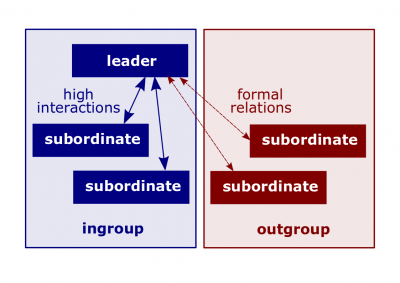Difference between revisions of "Leader-member exchange theory"
MariamKhalid (talk | contribs) |
|||
| (2 intermediate revisions by 2 users not shown) | |||
| Line 4: | Line 4: | ||
According to [[Organizational Behavior by Robbins and Judge (17th edition)]], | According to [[Organizational Behavior by Robbins and Judge (17th edition)]], | ||
:[[Leader-member exchange theory]]. A theory that supports leaders' creation of [[ingroup]]s and [[outgroup]]s; subordinates with ingroup status will have higher performance ratings, less turnover, and greater [[job satisfaction]]. | :[[Leader-member exchange theory]]. A theory that supports leaders' creation of [[ingroup]]s and [[outgroup]]s; subordinates with ingroup status will have higher performance ratings, less turnover, and greater [[job satisfaction]]. | ||
| + | According to [[Management by Robbins and Coulter (14th edition)]], | ||
| + | :[[Leader-member exchange theory]]. The leadership theory that says leaders create in-groups and out-groups and those in the in-group will have higher performance ratings, less turnover, and greater [[job satisfaction]]. | ||
| − | ==Related | + | ==Related lectures== |
*[[Leadership Quarter]]. | *[[Leadership Quarter]]. | ||
| − | [[Category: Septem Artes Administrativi]][[Category: Articles]] | + | [[Category:Management]][[Category: Septem Artes Administrativi]][[Category: Articles]] |
Latest revision as of 16:21, 3 June 2020
Leader-member exchange theory (alternatively known as LMX theory; hereinafter, the Theory) is the leadership theory that says leaders create ingroups and outgroups and those in the ingroup will have higher performance ratings, less turnover, and greater job satisfaction.
Definitions
According to Organizational Behavior by Robbins and Judge (17th edition),
- Leader-member exchange theory. A theory that supports leaders' creation of ingroups and outgroups; subordinates with ingroup status will have higher performance ratings, less turnover, and greater job satisfaction.
According to Management by Robbins and Coulter (14th edition),
- Leader-member exchange theory. The leadership theory that says leaders create in-groups and out-groups and those in the in-group will have higher performance ratings, less turnover, and greater job satisfaction.
